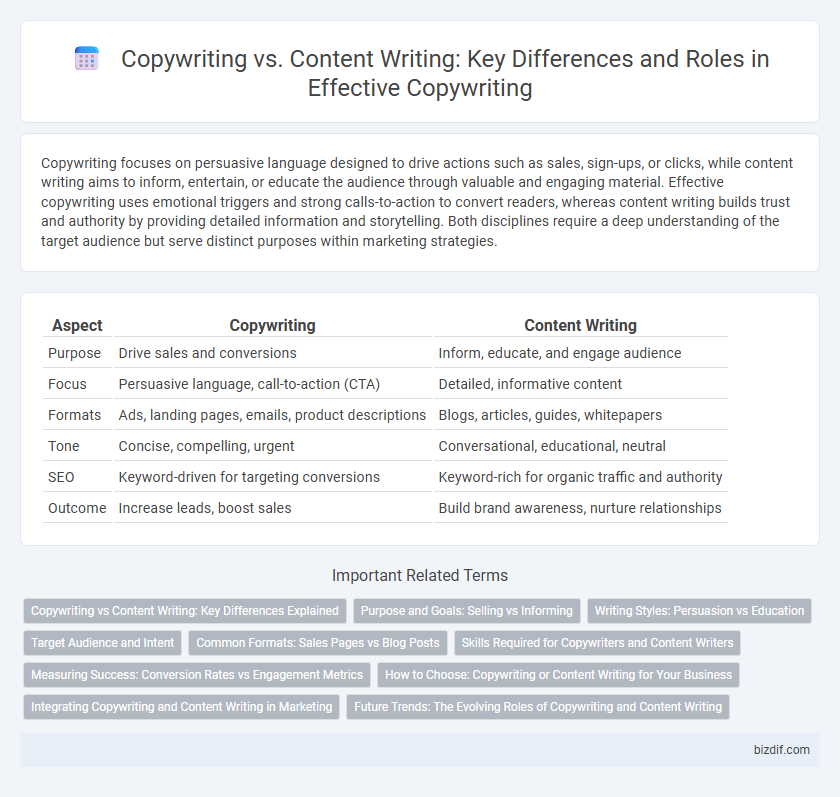Copywriting focuses on persuasive language designed to drive actions such as sales, sign-ups, or clicks, while content writing aims to inform, entertain, or educate the audience through valuable and engaging material. Effective copywriting uses emotional triggers and strong calls-to-action to convert readers, whereas content writing builds trust and authority by providing detailed information and storytelling. Both disciplines require a deep understanding of the target audience but serve distinct purposes within marketing strategies.
Table of Comparison
| Aspect | Copywriting | Content Writing |
|---|---|---|
| Purpose | Drive sales and conversions | Inform, educate, and engage audience |
| Focus | Persuasive language, call-to-action (CTA) | Detailed, informative content |
| Formats | Ads, landing pages, emails, product descriptions | Blogs, articles, guides, whitepapers |
| Tone | Concise, compelling, urgent | Conversational, educational, neutral |
| SEO | Keyword-driven for targeting conversions | Keyword-rich for organic traffic and authority |
| Outcome | Increase leads, boost sales | Build brand awareness, nurture relationships |
Copywriting vs Content Writing: Key Differences Explained
Copywriting focuses on persuasive, action-driven text designed to convert readers into customers, often seen in advertisements, sales pages, and email campaigns. Content writing aims to inform, educate, or entertain, enhancing SEO through blog posts, articles, and website content. Understanding these key differences helps businesses allocate resources effectively to meet marketing goals and audience needs.
Purpose and Goals: Selling vs Informing
Copywriting centers on persuading audiences to take specific actions, primarily driving sales and conversions by crafting compelling calls to action and emotional triggers. Content writing aims to inform, educate, or entertain readers by providing valuable and relevant information that builds trust and brand authority. Understanding these distinct goals ensures targeted messaging that effectively meets business objectives in marketing strategies.
Writing Styles: Persuasion vs Education
Copywriting employs persuasive writing styles designed to drive action and conversion, often using emotional triggers and compelling calls-to-action. Content writing prioritizes educational and informative styles intended to build trust, provide value, and engage readers through detailed explanations and storytelling. The distinct goals influence tone, structure, and language choice, optimizing each for either sales or audience education.
Target Audience and Intent
Copywriting targets a specific audience with the intent to persuade and drive immediate action, such as purchasing or signing up. Content writing focuses on providing valuable information to educate or entertain a broader audience, fostering trust and long-term engagement. Understanding the distinction between persuasive intent in copywriting and informative intent in content writing is crucial for effective communication strategies.
Common Formats: Sales Pages vs Blog Posts
Sales pages in copywriting are designed to drive conversions through persuasive language, compelling calls-to-action, and a focus on features and benefits tailored to target audiences. Blog posts in content writing prioritize providing valuable, informative content aimed at building trust, educating readers, and improving SEO through relevant keywords and consistent posting. Understanding the strategic goal behind each format--sales pages for immediate impact and blog posts for long-term engagement--is crucial for optimized marketing outcomes.
Skills Required for Copywriters and Content Writers
Copywriting requires strong persuasive skills, a deep understanding of target audience psychology, and expertise in crafting concise, impactful calls-to-action to drive conversions. Content writing demands excellent research abilities, proficiency in SEO techniques, and the talent to produce informative, engaging, and well-structured articles that build audience trust. Both disciplines necessitate excellent command of language and adaptability to different tones and formats, yet their core skills diverge significantly based on their marketing goals.
Measuring Success: Conversion Rates vs Engagement Metrics
Copywriting success is primarily measured by conversion rates, reflecting how effectively the text drives specific actions like sales or sign-ups. Content writing, on the other hand, is evaluated through engagement metrics such as time on page, social shares, and comments, indicating audience interaction and value. Understanding these distinct KPIs helps tailor strategies for optimizing marketing outcomes in digital campaigns.
How to Choose: Copywriting or Content Writing for Your Business
Choosing between copywriting and content writing depends on your business goals: prioritize copywriting for direct response, lead generation, and sales-oriented messaging, while content writing suits brand awareness, customer education, and long-term engagement. Analyze your target audience's needs and conversion funnel stage to determine which approach drives higher ROI and aligns with your marketing strategy. Integrate both disciplines when possible to build trust and nurture prospects through compelling, tailored communications.
Integrating Copywriting and Content Writing in Marketing
Integrating copywriting and content writing in marketing enhances brand messaging by combining persuasive calls to action with informative, value-driven narratives that engage target audiences effectively. Utilizing copywriting techniques within content pieces increases conversion rates, while content writing supports SEO goals through keyword-rich, relevant material. This synergy fosters a cohesive marketing strategy that drives customer acquisition and retention across digital platforms.
Future Trends: The Evolving Roles of Copywriting and Content Writing
The future of copywriting and content writing is shaped by advancements in AI-driven personalization and data analytics, enhancing targeted messaging and audience engagement. Copywriting will increasingly focus on crafting concise, persuasive calls-to-action optimized for digital platforms, while content writing evolves toward producing in-depth, value-rich narratives that build brand authority. Integration of multimedia elements and interactive content will further differentiate the roles, with copywriting emphasizing conversion and content writing prioritizing user education and retention.
Copywriting vs Content Writing Infographic

 bizdif.com
bizdif.com